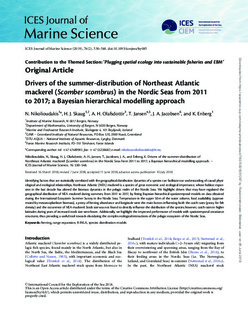| dc.contributor.author | Nikolioudakis, Nikolaos | |
| dc.contributor.author | Skaug, Hans J. | |
| dc.contributor.author | Olafsdottir, Anna H. | |
| dc.contributor.author | Jansen, Teunis | |
| dc.contributor.author | Jacobsen, Jan Arge | |
| dc.contributor.author | Enberg, Katja | |
| dc.date.accessioned | 2020-01-17T07:55:46Z | |
| dc.date.available | 2020-01-17T07:55:46Z | |
| dc.date.created | 2019-04-26T16:00:31Z | |
| dc.date.issued | 2019 | |
| dc.identifier.citation | ICES Journal of Marine Science. 2019, 76 (2), 530-548. | nb_NO |
| dc.identifier.issn | 1054-3139 | |
| dc.identifier.uri | http://hdl.handle.net/11250/2636735 | |
| dc.description.abstract | Identifying factors that are statistically correlated with the geographical distribution dynamics of a species can facilitate our understanding of causal physiological and ecological relationships. Northeast Atlantic (NEA) mackerel is a species of great economic and ecological importance, whose habitat expansion in the last decade has altered the biomass dynamics in the pelagic realm of the Nordic Seas. We highlight drivers that may have regulated the geographical distribution of NEA mackerel during summers, from 2011 to 2017, by fitting Bayesian hierarchical spatiotemporal models on data obtained during the International Ecosystem Summer Survey in the Nordic Seas. Temperature in the upper 50 m of the water column, food availability (approximated by mesozooplankton biomass), a proxy of herring abundance and longitude were the main factors influencing both the catch rates (proxy for fish density) and the occurrence of NEA mackerel. Stock size was not found to directly influence the distribution of the species; however, catch rates in higher latitudes during years of increased stock size were lower. Additionally, we highlight the improved performance of models with spatiotemporal covariance structures, thus providing a useful tool towards elucidating the complex ecological interactions of the pelagic ecosystem of the Nordic Seas. | nb_NO |
| dc.language.iso | eng | nb_NO |
| dc.title | Drivers of the summer-distribution of Northeast Atlantic mackerel (Scomber scombrus) in the Nordic Seas from 2011 to 2017; a Bayesian hierarchical modelling approach. | nb_NO |
| dc.type | Journal article | nb_NO |
| dc.type | Peer reviewed | nb_NO |
| dc.description.version | publishedVersion | nb_NO |
| dc.source.pagenumber | 530-548 | nb_NO |
| dc.source.volume | 76 | nb_NO |
| dc.source.journal | ICES Journal of Marine Science | nb_NO |
| dc.source.issue | 2 | nb_NO |
| dc.identifier.doi | 10.1093/icesjms/fsy085 | |
| dc.identifier.cristin | 1694276 | |
| dc.relation.project | Norges forskningsråd: 243895 | nb_NO |
| cristin.unitcode | 7431,8,0,0 | |
| cristin.unitcode | 7431,25,0,0 | |
| cristin.unitcode | 7431,0,0,0 | |
| cristin.unitname | Fiskerifaglig senter | |
| cristin.unitname | Sjøpattedyr | |
| cristin.unitname | Havforskningsinstituttet | |
| cristin.ispublished | true | |
| cristin.fulltext | original | |
| cristin.qualitycode | 1 | |
